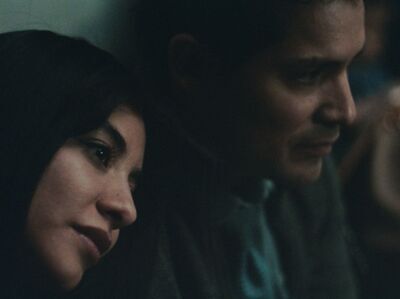Luis Fernando Puente’s “I Have No Tears, and I Must Cry” takes place in the confines of an immigration office where lives are forever changed, providing the prospective citizens correctly filled out their paperwork and followed the rules of citizenship. Lives are either made or broken in these tiny offices where bureaucrats check and double-check all the filings all day long while people who are eager to start a new life bite their nails in hopes of getting everything stamped, notarized and approved. The stress is unbearable. One slip-up, one missing signature, one decision made outside of an approved window of time and it’s back to square one.
Maria Luisa (Alejandra Herrera) and her husband (Enoc Oteo) arrive at such a facility, eager to finally be done with the long wait and the stranglehold of bureaucracy that has been overwhelming them for the past several months. The plan for the day is to get this meeting over with, get the green card and then shop for a new couch. They’ve been over this and over this. They xeroxed everything that needs to be xeroxed and feel ready to present themselves to the authorities as new American citizens. When they enter, they are greeted warmly by the security guard who congratulates them on finally making it to this final stage in the process.
Then, they get into the small, darkly lit office with nary a trace of life or optimism. Their case handler (Cherie Julander) coldly goes through their files, asking them about their marriage, when they decided to get married, how they’re related to some of the names on the forms, and why no one stamped their passport upon entry from Mexico. Her level of frustration with this couple continues to grow and we suspect she feels this way all day long. Maybe it’s a power trip. Maybe it’s a lack of compassion and empathy. Maybe it’s just her job to be tough with the rules. Possibly all three. Whatever the case, they are at her mercy.
One of the many strengths of this piece is that Puente’s script never spells out why Julander’s character is the way she is. We have to infer that for ourselves, but her manner likely represents what it feels like for anyone who has to go through something like this, or any American citizen who has to go in for a passport, driver’s license or work permit. No matter how thorough one can be with following the rules and providing the correct documents, there is always someone on the other side of the counter who has the thankless job of having to look for errors and proceed accordingly.
Herrera’s performance tells the whole story, though. She effortlessly takes us on the journey from hope to hopelessness and back again. It’s really something to see in a 13-minute span. We leave the movie hoping her world of possibilities hasn’t closed up and that she’ll feel a little better at the end of the day, even though we know this story in real life often doesn’t end the way it should.
Much of Puente’s film is shot in effective, tight close-ups, utilizing the 4:3 frame as a way to make this room feel that much smaller as hope continues to diminish. The first time seeing the film, I worried that this would be another one of those shorts that starts strong but fails to find an ending (ambiguous endings have become too much of a crutch for many shorts lately). Puente makes us wonder what happened with this couple, not with a random blackout, but with a hope that they have to manufacture themselves in order to keep going. “I Have No Tears, and I Must Cry” is a small film about a big subject, one that often gets overlooked when talking about immigration in the United States.
How did this film come about?
This film is based almost word for word on Lizde Arias’ (my wife) real interview for her green card. I was her sponsor for her marriage-based, residency application, so we were both in that room answering questions. The result was not what we were expecting. We went about making sure we checked every box, and in hindsight having some sort of legal help would have been nice, but we could not afford a lawyer at the time. After all was resolved we thought about the power that this story could have on the conversation surrounding immigration in the US, not only for immigrants to feel identified with it, but also for those who are unfamiliar with what immigration in the US actually looks like.
Do you know other people who have had this experience?
Everyone’s experience dealing with USCIS is very different. My own experience applying for a green card and citizenship was very different because I came to the US as a kid, and I became naturalized at 18, more than ten years ago. It was a relatively streamlined process. There are people who claim their USCIS officer asked them a lot more questions than my wife was asked, and we know people who were less than half prepared for their interview and their green card was approved very easily. However, even though everyone’s case is different, the stakes are always the same. There is always a possibility of deportation or needing to leave the country, if the process goes awry, and filling out applications, paying filing fees, dealing with expensive lawyer fees, everyone goes through that.
How did you and/or Cherie Julander approach her character?
I think there is a practicality to the approach of USCIS officers. Ours in real life was cold, stern, calculated, by the book. I think about the people working in USCIS needing to detach themselves from the individual, and going off of what they see on the page. This is what I told Cherie to think about. I told her to imagine that years ago, when she first started this job, she really cared, and wanted to make a difference for aspiring immigrants and their families, but the years of having to bear bad news several times, had calloused her, and the slightest questioning of her own authority is a threat, so she has to put her foot down. She made it so Maria Luisa’s character was discouraged from digging deeper or questioning the reasoning behind the officer’s accusations. Cherie was able to deliver a pretty intuitively cold demeanor, not mean, but stern.
If you can speak to this, what was Alejandra Herrera’s experience like with her character?
Ale connected very much with the character. She mentioned in the past having to argue with US immigration officers for her eligibility to even just have a visa to come to the US. She also mentioned to me what went on in her mind when she was being optimistic for the future as Maria Luisa. She thought about the life Maria Luisa left behind in Mexico, and the opportunities she could have in the US. She also understood the relationship of the story from the beginning. No one really wants to leave their country, unless they have a good reason, and for Maria Luisa it’s her relationship with Jorge. Ale really understood that. Her potentially not being able to stay in the US also means she would not be able to be with Jorge. Ale also spent a good amount of time getting to know Lizde, whom the character is fundamentally based on, and she managed to pick up even some of her mannerisms and character, but in the end she made the character her own and delivered one of the best performances I’ve ever worked with.
Curiously, the film opens with a distorted shot of the couple in their car. I’m curious about yours and your cinematographer’s process of finding your way through a scene visually. What’s the overall experience you want audiences to have?
I am fascinated by this idea that looking through a glass, or a reflection, is a subjective vision. It’s filtered. I wanted to explore visually what the illusion of safety was with Maria Luisa and Jorge, so we looked at reflections, and shot through pieces of glass. Shooting through the side mirror of the car is meant to convey a sort of false reality. When Oscar Jimenez (my cinematographer) and I start looking through reference we begin looking at images thematically. One film we referenced was Dreyer’s The Passion of Joan of Arc, and that pretty much set the basis of what we wanted to work with because its frames express so much. We chose to shoot very tight, limiting the field of vision of the audience to get in the same headspace the characters are in, which is a limited perspective of their circumstances. It coincidentally helped us create claustrophobia and it really raised the tension during the interview. We added the glass elements we wanted to add, some filters and even scanned our finished film through Super 16 to add texture and grit to the image. I really like images that feel lived in and well worn.
What have the reactions to the film been like?
Overall people have connected really well with the film. The immigrants who have watched it connect with it very closely, which is a great sign for me, because that was my primary audience. I’m glad I was able to make something that they could feel identified with. There was even a USCIS officer who saw the film, and had great things to say about it, that I know of. I attempted to recreate a scene as close to real life as I remember it, and even though I know there is a bias on how my wife and I experienced this particular event in our life, I also know there are people who won’t connect with it the way I chose to portray it, and I think that’s ok. Overall, however, it’s had a great reception, and I feel very satisfied with the result.
What’s next for you?
I want to make a feature version of this story. I want to tell a more complete story of what happens to Maria Luisa and Jorge and the many more obstacles they face in this journey through US immigration. In the meantime, while I find a producer who is interested in taking this project through to the end, I’m working on a short that I’m shooting pretty soon. It’s written by Lizde and is going to be shot by Oscar as well. I’m exploring something different from immigration with this one. It deals with more existential questions of faith, death, and relationships. I’m excited to make it and have people watch it in the near future.





